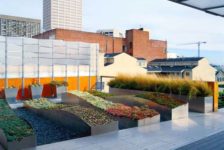Vertical gardening in any climate can be extremely complex. The regional climate, or plant hardiness zone, is the biggest overriding climatic aspect that needs to be considered, along with the neighbourhood microclimate, and the microclimate of the wall itself.
 USDA Hardiness Zones in North America, image via Wikipedia
USDA Hardiness Zones in North America, image via Wikipedia
REGIONAL CLIMATE
The regional climate plays a big role in determining what kind of vertical garden system is appropriate for a given site. As an example, if the site experiences a long winter below 0°C, a hydroponic system would be out of the question if the garden is to stay in place throughout the winter. These types of systems are not designed to freeze, and if they are installed in colder climates, insulation/heating or complete removal will be necessary to protect the garden during the winter. While most outdoor vertical gardens are designed for warmer climates than USDA zone 5, researchers are currently working on developing a system that works well in colder climates. If you know of, or have worked on, a vertical garden project somewhere colder, please post a comment below to share!
NEIGHBOURHOOD MICROCLIMATES
 Ecotect Shadow Analysis, image by Tamara Urben-Imbeault
Ecotect Shadow Analysis, image by Tamara Urben-Imbeault
In landscape architecture, we often plan our designs in response to, or for the creation of, microclimates. It is because of them that we are able to plant some species that would normally not be found within the given region. A vertical garden may be highly dependent on the existence of a microclimate for shelter from the wind, lower (or higher) than average temperatures, higher humidity levels, or a variety of other aspects, depending on the location. When planning a vertical garden it is important to know what kind of microclimate you are working within to determine if a vertical garden is appropriate or not, and if so, what kind of plants you should use.
Some of the most important things to consider when designing a vertical garden are: the average temperature (as well as the extremes), wind exposure, sun exposure and ambient humidity and access to water. The average temperature will tell you which plants will be able to survive in your garden, and details like solar orientation and humidity or access to water will further narrow the plant palette.
RELATED STORY: Vertical Gardens: A Brief Introduction
 Autodesk Flow Design Wind Analysis, image by Tamara Urben-Imbeault
Autodesk Flow Design Wind Analysis, image by Tamara Urben-Imbeault
WALL MICROCLIMATES
Wall Microclimate, image ©Tamara Urben-Imbeault
The microclimate of a wall is also remarkably complex, ranging from hot and dry, to slightly cooler, and to more moist. A green wall is a gradient of different climatic scenarios, and may vary from wall to wall depending on the surrounding climate and microclimate. Toward the top of the wall there is often increased solar exposure (depending on the prevalence of shadows cast by adjacent buildings), and increased wind. These two factors together frequently result in decreased moisture content in a vertical garden.
There is often more shade towards the bottom of the wall (again due to neighbouring buildings) as well as lower wind speeds which result in an increase in moisture. Water within the vertical garden will also accumulate towards the bottom of the wall, contributing to higher moisture levels. The first storey of a facade will also face increased disturbance from people, animals and passing cars. Between 2 – 7.5m in elevation, dust will be captured on the leaves of the garden: If dust uptake is a priority, plant species with large leaves should be chosen, as the amount of dust accrued is directly relative to the size of the leaf itself.
RELATED STORY: A History of Vertical Gardens From Simple Vines to Hydroponic Systems
Climates are extremely complex and constantly changing. With global climate change, weather is becoming increasingly unpredictable, but with the aid of new technology, and programs like Ecotect and Autodesk Design Flow (pictured above), we can further study the impact of the climate on our designs. It is important that we also take the time to visit the site, and make our own notes and observations.
My own personal notes and observations of naturally occurring vertical gardens (cliffs) will be the subject of the next Vertical Garden Series post, which will be published next Thursday, so stay tuned!
Written by Tamara Urben-Imbeault, M.L.Arch. student at the University of Manitoba, Winnipeg, Manitoba, Canada. She is currently working on her design thesis entitled “Vertical Gardening in Cold Weather Climates”
Contact: umurbeni[at]myumanitoba.ca or t.urbendesign[at]gmail.com
Sources
Bass B., Baskaran B. (2003) Evaluating Rooftop and Vertical Gardens as an Adaptation Strategy for Urban Areas, Institute for Research and Construction, NRCC-46737, Project number A020, CCAF Report B1046, Ottawa, Canada, National Research Council.
Green Roofs for Healthy Cities, GRHC (2010) Green Walls 101: Systems Overview and Design Second Edition Participant’s Manual. Green Roofs for Healthy Cities.
Kohler, M., 2008. Green Facades – A view back and some visions. Urban Ecosystems 11, 423-436.
Loh, Susan and Stav, Yael (2008) Green a city grow a wall. In: Proceedings of the Subtropical Cities 2008 Conference : From Fault-lines to Sight-lines : Subtropical Urbanism in 20-20, 3-6 September 2008, State Library of Queensland, Brisbane, Queensland.
Peck SW, Callaghan C, Bass B, Kuhn ME (1999). Research Report: Greenbacks from Green Roofs: Forging a New Industry in Canada. Ottawa, Canada: Canadian Mortgage and Housing Corporation (CMHC).
Stav, Yael (2008) Living Walls and Their Potential Contribution to Urbanism in Brisbane. Queensland University of Technology. Brisbane, Queensland. Retrieved from: http://www.academia.edu/1326234/Living_Walls_and_Their_Potential_Contribution_to_Sustainable_Urbanism_in_Brisbane
Published in Blog










Andrew Bolt
Hi Tamara..thanks again for posting such great information.
Great point on the hydroponic systems freezing in winter, I don’t think many designers have given this a second thought.
You did mention the moisture factor in vertical green walls being a consideration. I would encourage your readers to spend more time putting thought into how one irrigates these walls. Having worked and consulted on many walls in the past I can honestly say that under and over watering has been one of our biggest issues. Far too little time is spent on the consideration of how the water moves through these walls and how much and where the water ends up.
Management of these walls are so important so why make it complicated for the owner, think the product, design and installation through and you will end up with a great project, and don’t always assume that an expert will be maintaining these projects. Simpler the better..less is more. I have consulted on projects where the janitor has also been employed as the “horticulturist” ?..Fortunately good consultants were available to guide the maintenance, but not a good idea.
Maybe one of your future articles could include why good irrigation design is so critical.
Thanks again for the article, keep them coming.
Tamara Urben-Imbeault
Wow, great point Andrew!
What recommendations would you make to alter hydroponic systems so that things like rot and over-saturation don’t happen? As I understand it, most of these systems are outfitted with automatic timers to make sure they are kept moist enough to keep the plants healthy, but not too wet as to drown them… I suppose that if the timers are improperly set that could cause a lot of problems. Are those pictures the result of irrigation system failure or human error?
As for the recycling of water- and please correct me if I’m wrong- I think that the theory is that once the water cycles through the system, it is “cleaned” by the plants, a rudimentary form of phytoremediation I suppose. I agree that the system should be cleansed with new water every so often so it doesn’t get stale, but in order to cut down the amount of water used, I think the recycling is a good idea. I’m very curious to hear more of your thoughts on this. I’m coming from a purely academic background, and it sounds like you have had lots of hands on professional experience, so I am very interested to hear more.
I am currently designing a vertical garden for my design thesis, and I am considering harvesting rainwater for irrigation. Have you done or seen any projects that use rainwater?
Tamara Urben-Imbeault
Forgot to add in a big giant thank you to Andrew for sharing some of your experience and knowledge with the community!! If anyone agrees or disagrees with anything Andrew or I have said, please comment and let us know!
George Irwin
It has been nice to sit on the sidelines reading others comments. As a global leader in green roof and wall technology…the reality is….Hydroponics is a fine line between success and failure. There are simply too many variables including but not limited to:
Temps, Nutrient solutions, pH, quantity and quality of water,etc….much of which is impacted by environmental variables. If one of these variables is wrong the wall / plants stress, fail or both.
In general there is a design flaw in the majority of the hydro type walls, especially the felt. To Andrews point the irrigation is a contributing factor. Common design sandwiches the root system between two pieces of inorganic substrate be it felt, doodle bug scrub pads etc…leaving no room for oxygen exchange at the root level because the roots are being saturated to prevent them from drying out. The result….root rot. Check out a good read on the subject matter via
http://www.greenroofs.com/archives/green_walls.htm
I am also the Green Wall Editor for Greenroofs.com.
Last point on irrigation….too much water is also the leading cause of insect infestation. *I posted an article on “Lighting Living Walls” to detail the importance of light / water ratios…I haven’t seen it on Land 8 yet only to assume it still waiting approval….if its not posted here you can read it via the news in our site at http://www.agreenroof.com
There are two types of hydro or ways to irrigate these walls….Drain to waste and recirculating the water via reservoirs. Drain to waste, simple….water in and water out. Ideally calibrating your irrigation to the system of choice (not so easy) should leave you with virtually zero waste water. Recirculating water will have to be replaced every week to 10 days anyway, pathogens are the number one relation to failure and can be avoided via cleaning. So where does the water go? Fertilizer infused water down the drain….same thing with green roofs….a fertilized green roof is more an environmental problem than a solution…As for rain water capturing, yes viable, in fact we have a rain water collection top trim we use for exterior living walls. (See pic)
Im outspoken in the industry and have a reputation for calling out poorly designed products and systems however I also have documentation to back up my claims. The hype of the green wall revolution is being over run by “One time use” products or products someone is making in a garage. It is the wild west!
Needless to say my comments on the use of felt and hydro is combined experience and fact.
Here is a close up of the Athenaeum Hotel via the famous Patrick Blanc….Needless to say many have copied his techniques and suffer some of the same results.
J. Robert (Bob) Wainner
I have recently read an article from one of the World’s foremost authorities on the Global Weather issues…..he was one of the co-founders of “Greenpeace”. He stated that data shows that the Earth’s temperature has changed by only 1 degree since 1900. So, when you think of all of the development World wide, that’s a drop in the bucket.
I think it’s definitely a positive when Landscape Architects, our Gov’t and the general population do whatever they can to with regards to conservation, recycling and good environment design…but, even if every single person in the U.S. were to be proactive concerning our environment concerns…..what about China, India, Russia, Iran…..the rest of the World. The U.S. cannot legislate “green energy” policies outside of our Nation. And, we can’t exactly built a wall around America to keep pollution from other Nations out.
It’s a scientific FACT, the Earth has been going through changes for millions of years. The time PEOPLE will be here “visiting” on the Planet Earth is like a single grain of sand on a huge beach.
IMO….the terms “climate change” & “Global Warming” have been created by politicians….for the betterment of the “green energy” industry and to degrade the oil, coal and natural gas industries of America. If we all had cars that ran on batteries, where does everyone believe the electrical energy would come from??? It comes from the oil, coal and natural gas industries.
I believe way too many University Professors (liberals mostly) have bought into the “green energy” movement…and are passing this “philosophy” on to their students. I can guarantee you, green energy type projects in the REAL WORLD are few and far between. Most of those types of projects are Gov’t sponsored, not private developer projects. It may be a great cause, but, try earning a living off of the “green energy” movement.